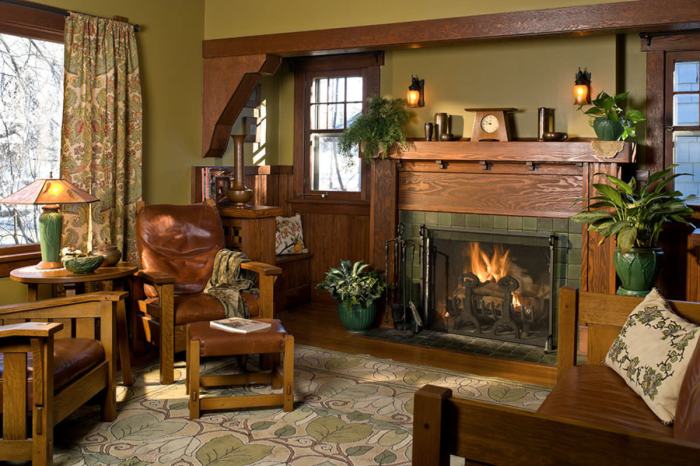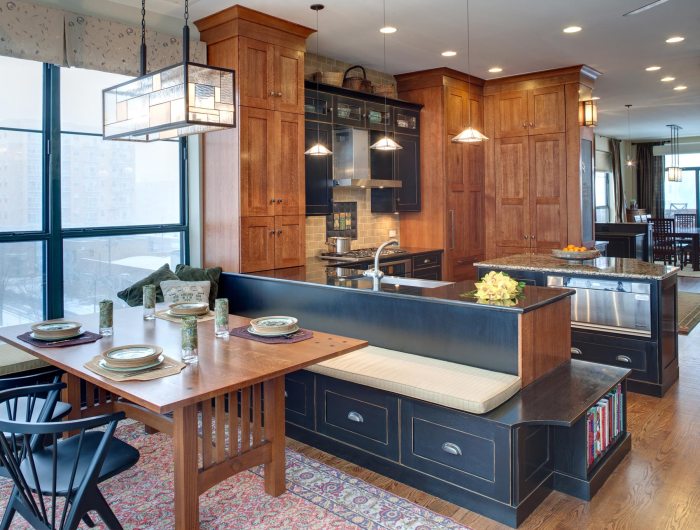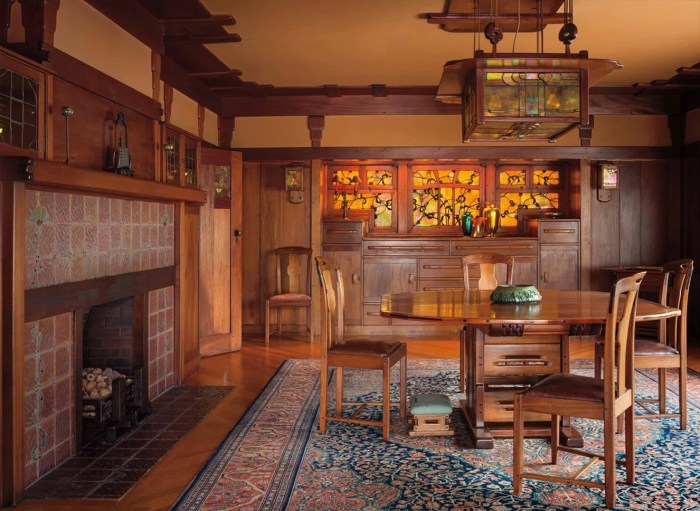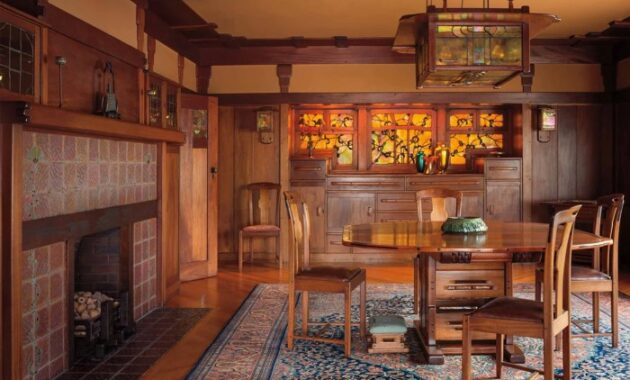Arts and crafts house interior design – Arts & Crafts house interior design embodies a timeless aesthetic that seamlessly blends functionality with beauty. This style, born from a desire to reclaim handcrafted artistry in a rapidly industrializing world, emphasizes natural materials, handcrafted elements, and a focus on creating spaces that are both welcoming and practical.
From the use of rich wood tones and earthy colors to the incorporation of handcrafted furniture and decorative objects, Arts & Crafts design offers a refreshing alternative to modern minimalism, fostering a sense of warmth, authenticity, and connection to nature.
The Essence of Arts & Crafts Design
The Arts & Crafts movement, which emerged in the late 19th century, was a reaction against the industrialization and mass production that was rapidly changing society. It emphasized handcrafted objects, natural materials, and a return to traditional craftsmanship. The movement’s influence can be seen in many aspects of modern design, including interior design.The Arts & Crafts movement was a reaction against the industrialization and mass production that was rapidly changing society.
It emphasized handcrafted objects, natural materials, and a return to traditional craftsmanship. The movement’s influence can be seen in many aspects of modern design, including interior design.
Core Principles of Arts & Crafts Design
The core principles of Arts & Crafts design are still relevant today. These principles can be used to create beautiful and functional spaces that are both timeless and comfortable.
Arts and Crafts house interior design emphasizes natural materials, handcrafted furniture, and a sense of warmth and functionality. While it often draws inspiration from traditional English styles, it can also be influenced by other aesthetics, such as the American style house interior design , which incorporates elements of colonial and rustic design.
This blend of influences allows for a unique and personalized approach to creating a comfortable and inviting living space.
- Handcrafted objects: The Arts & Crafts movement emphasized the importance of handcrafted objects. This was a reaction against the mass-produced goods that were becoming increasingly common at the time. Handcrafted objects were seen as being more unique, personal, and expressive.
- Natural materials: Arts & Crafts designers favored natural materials such as wood, stone, and leather. These materials were seen as being more beautiful and durable than the synthetic materials that were being used in mass production.
- Simple forms: Arts & Crafts design emphasized simple forms and clean lines. This was a reaction against the ornate and over-decorated styles that were popular in the Victorian era.
- Functional design: Arts & Crafts designers believed that form should follow function. This means that objects should be designed to be both beautiful and useful.
- Traditional craftsmanship: The Arts & Crafts movement emphasized the importance of traditional craftsmanship. Designers believed that skilled artisans could create objects of great beauty and quality.
Translating Arts & Crafts Principles into Modern Home Decor
The principles of Arts & Crafts design can be translated into modern home decor in a number of ways. For example, you can use natural materials such as wood, stone, and leather in your furniture and decor. You can also choose furniture with simple forms and clean lines.
Additionally, you can incorporate handcrafted objects into your home decor, such as pottery, textiles, and furniture.
Iconic Arts & Crafts Furniture Pieces
There are many iconic Arts & Crafts furniture pieces that continue to inspire contemporary designers. These pieces are known for their beauty, craftsmanship, and functionality.
- Morris Chair: Designed by William Morris, the Morris Chair is a classic example of Arts & Crafts furniture. The chair is known for its simple form, comfortable design, and use of natural materials. It was designed to be both beautiful and functional, with a high back and armrests to provide support and comfort.
- Stickley Mission Furniture: Gustav Stickley, an American furniture maker, was a leading figure in the Arts & Crafts movement in the United States. His furniture, known as Mission furniture, is characterized by its simple forms, sturdy construction, and use of natural materials.
Mission furniture is still popular today for its timeless appeal and durability.
- Arts & Crafts Tables: Arts & Crafts tables were often made from solid wood and featured simple, geometric designs. They were designed to be both beautiful and functional, and they were often used in dining rooms, living rooms, and libraries.
The Arts & Crafts movement had a profound impact on contemporary design. The movement’s emphasis on handcrafted objects, natural materials, and traditional craftsmanship continues to inspire designers today.
Embracing Simplicity and Functionality

The Arts & Crafts movement championed a philosophy that valued practicality and utility over ostentatious display. This principle is evident in the design’s emphasis on functionality, where every element serves a purpose and contributes to the overall harmony of the space.
Multi-Purpose Furniture
Multi-purpose furniture plays a pivotal role in maximizing space and embracing the spirit of functionality in Arts & Crafts interiors. These pieces are designed to serve multiple purposes, eliminating the need for separate items and contributing to a streamlined aesthetic.
For instance, a settle, a long bench with a back, can serve as seating, a storage space for blankets, or even a makeshift bed. Similarly, a trestle table can be used for dining, work, or as a display surface, offering versatility without compromising on style.
Arts and crafts house interior design emphasizes natural materials, handcrafted elements, and a sense of warmth. This style often features intricate woodwork, stained glass windows, and cozy furniture. To bring these design ideas to life, consider utilizing 3d interior house design software.
This allows you to visualize the finished product, experiment with different textures and colors, and make adjustments before committing to any changes. The result is a home that truly reflects your personal style and the timeless beauty of the arts and crafts movement.
Incorporating Storage Solutions
Storage solutions that blend seamlessly with the Arts & Crafts aesthetic are crucial for maintaining order and enhancing the overall visual appeal of the space. Built-in cabinets and shelves, crafted from natural materials like oak or pine, are a popular choice.
These integrated storage solutions create a sense of cohesion and provide ample space for storing belongings without sacrificing the visual integrity of the design.
Lighting and Window Treatments
The interplay of light and shadow is crucial in Arts & Crafts interiors, as it enhances the beauty of handcrafted furniture, intricate details, and natural materials. This section explores the role of natural light and the traditional window treatments that contribute to the distinctive atmosphere of Arts & Crafts homes.
Natural Light in Arts & Crafts Interiors
Natural light plays a fundamental role in Arts & Crafts interiors, illuminating the space with warmth and creating a sense of connection to the outdoors. Large windows, often featuring stained glass, were designed to maximize the influx of natural light, casting colorful patterns across the rooms.
This emphasis on natural light aligns with the movement’s philosophy of celebrating the beauty of nature and integrating it into the home.
Traditional Window Treatments
Arts & Crafts interiors often feature traditional window treatments that complement the style’s emphasis on simplicity and functionality. These treatments include:
- Curtains:Simple, unadorned curtains made from natural fabrics like linen or cotton are commonly used to provide privacy and soften the light. The curtains are often hung from wooden rods, adding to the rustic aesthetic of the space.
- Blinds:Wooden blinds are another popular choice for window treatments, offering light control and a touch of rustic charm. These blinds are often paired with curtains for added privacy and a layered look.
- Stained Glass:Stained glass windows are a signature feature of Arts & Crafts interiors, adding a touch of artistry and color to the space. These windows allow light to filter through, creating vibrant patterns and a warm, inviting atmosphere.
Dining Room Design with Large Windows
Imagine a dining room bathed in natural light, with large windows showcasing views of a lush garden. To create an Arts & Crafts ambiance in this space, consider these design elements:
- Window Treatments:Opt for simple linen curtains with a natural color palette, hung from a rustic wooden rod. Alternatively, consider incorporating wooden blinds for a more minimalist look.
- Lighting Fixtures:Install a handcrafted pendant light made from wrought iron or stained glass, adding a touch of artistry to the space. Complement the pendant light with wall sconces featuring a similar design aesthetic.
- Furniture:Choose a solid wood dining table with simple, sturdy chairs. The furniture should be handcrafted and feature a natural finish that complements the room’s color scheme.
- Decor:Add a touch of color and texture with handmade pottery, woven baskets, and floral arrangements.
Incorporating Art & Craftsmanship

The Arts & Crafts movement celebrated the artistry of handcrafted objects, placing a premium on unique, well-made pieces that reflected the skill of the maker. These elements are vital to creating an authentic Arts & Crafts interior.
Displaying Handcrafted Artwork and Decorative Objects
Handcrafted artwork and decorative objects add character and warmth to an Arts & Crafts home. Here are some ideas for displaying these treasures:
- Create a gallery wall:Group together a collection of framed prints, photographs, or paintings. Vary the sizes and frames for visual interest. Use a consistent color scheme or theme to unify the display.
- Showcase pottery and ceramics:Place handcrafted bowls, vases, and mugs on open shelves, mantels, or windowsills. Consider grouping items by color, shape, or material.
- Display woven textiles:Hang tapestries, rugs, or throws on walls, or drape them over furniture. Choose fabrics with natural textures and patterns, such as wool, linen, or cotton.
- Use decorative objects as focal points:Place a handcrafted lamp, a hand-carved wooden box, or a metal sculpture on a table or shelf. Choose pieces that reflect your personal style and interests.
Traditional Techniques for Decorative Elements
The Arts & Crafts movement championed traditional techniques like weaving, pottery, and metalwork, which are still relevant today.
- Weaving:Weaving is a versatile technique that can be used to create a variety of decorative elements, from rugs and tapestries to baskets and wall hangings. Look for pieces made from natural fibers like wool, linen, or cotton.
- Pottery:Pottery is a timeless craft that can be used to create beautiful and functional objects. Choose pieces with unique glazes, patterns, or textures.
- Metalwork:Metalwork is another traditional craft that can be used to create decorative elements for the home. Look for pieces made from copper, brass, iron, or silver.
Collection of Handcrafted Items
| Category | Example | Description |
|---|---|---|
| Ceramics | Hand-thrown ceramic bowl with a rustic glaze | The bowl’s irregular shape and uneven glaze reflect the artisan’s skill and the handmade nature of the piece. |
| Woven Textiles | Wool tapestry with geometric patterns | The tapestry’s intricate patterns and natural wool fibers create a warm and inviting ambiance. |
| Metalwork | Copper lamp with a hammered finish | The lamp’s unique texture and warm copper tones add a touch of handcrafted elegance to the room. |
The Modern Arts & Crafts Home
The Arts & Crafts movement, with its emphasis on handcrafted details and natural materials, has stood the test of time. But, how can you incorporate its principles into a contemporary setting without sacrificing modern sensibilities? This section explores the art of blending traditional Arts & Crafts elements with modern aesthetics, creating a home that is both timeless and relevant.
Incorporating Modern Elements, Arts and crafts house interior design
Blending modern elements into a traditional Arts & Crafts interior requires a careful balance. While embracing the core values of craftsmanship, simplicity, and natural materials, you can inject a contemporary feel with carefully chosen furniture, accessories, and design techniques. Here are some ways to achieve this balance:
- Embrace Clean Lines:Modern design often favors clean, minimalist lines. Introduce this into your Arts & Crafts space by selecting furniture with sleek silhouettes and minimal ornamentation. For example, a modern sofa with a low profile and simple upholstery can provide a contemporary touch while still complementing the Arts & Crafts aesthetic.
- Use Bold Colors:Traditional Arts & Crafts interiors often rely on a muted palette of earth tones. To add a modern twist, introduce bolder colors as accents. This could involve a vibrant throw pillow on a traditional sofa, a colorful rug, or a piece of artwork with a bold color scheme.
- Introduce Geometric Patterns:While Arts & Crafts design embraces organic forms, modern design often features geometric patterns. Incorporate geometric elements into your Arts & Crafts space through textiles, wallpaper, or even artwork. For instance, a geometric patterned rug can create a focal point in a room and add a contemporary touch.
- Embrace Minimalism:The Arts & Crafts movement emphasizes functionality, but modern design often embraces minimalism. This principle can be applied to your Arts & Crafts home by decluttering and keeping surfaces clear. Choose furniture with built-in storage solutions to minimize clutter.
Contemporary Furniture and Accessories
There are many contemporary furniture and accessory options that can complement the Arts & Crafts aesthetic.
- Mid-Century Modern Furniture:Mid-century modern furniture, with its emphasis on clean lines and organic forms, blends seamlessly with Arts & Crafts principles. A classic Eames lounge chair, for example, can add a touch of contemporary sophistication to a traditional Arts & Crafts living room.
- Scandinavian Furniture:Scandinavian design, known for its simplicity and functionality, also complements Arts & Crafts interiors. A Scandinavian-style dining table with a simple wooden frame and natural finish can provide a modern yet timeless touch.
- Geometric Lighting:Modern lighting often features geometric shapes and materials. A geometric pendant lamp or a modern floor lamp can add a contemporary touch to a traditional Arts & Crafts space.
- Natural Materials:Arts & Crafts design prioritizes natural materials like wood, leather, and wool. Choose contemporary accessories that reflect this principle, such as a leather ottoman, a wool throw blanket, or a wooden bowl for decorative storage.
Modern Arts & Crafts Bedroom
A modern Arts & Crafts bedroom can seamlessly blend vintage and modern elements, creating a space that is both comfortable and stylish. Imagine a bedroom with a mix of vintage and modern furniture, incorporating Arts & Crafts principles and color schemes:
- A vintage Arts & Crafts bed framewith a simple headboard and footboard, crafted from solid wood with a natural finish, forms the foundation.
- A modern bedside tablewith clean lines and a sleek metal frame provides a contemporary contrast.
- A geometric patterned rugin muted tones adds a touch of modern sophistication.
- A vintage Arts & Crafts dresserwith intricate carvings and a warm wood finish provides storage space and adds character.
- A modern pendant lampwith a geometric design hangs above the bedside table, casting a warm glow.
- The walls are painted in a soft, neutral color, such as a warm gray or a pale green, reflecting the Arts & Crafts emphasis on natural tones.
- The window treatments are simple and elegant, perhaps a pair of linen curtains with a subtle pattern.
- Artwork and accessories are carefully curatedto create a cohesive look. A framed botanical print, a hand-thrown ceramic vase filled with fresh flowers, and a stack of vintage books add personality and warmth.
Creating a Unique Arts & Crafts Style
While the Arts & Crafts movement emphasizes simplicity and functionality, it also allows for a personal touch. By incorporating your own unique style, you can create a home that reflects your personality and interests.
Incorporating Personal Collections, Family Heirlooms, and Travel Souvenirs
These items hold sentimental value and can add a unique touch to your Arts & Crafts interior. Here are some tips:
- Display family heirlooms: A vintage grandfather clock, a hand-stitched quilt, or a collection of antique china can add a touch of history and family heritage to your home. You can place these items in a prominent location, such as the living room or dining room, or use them as decorative accents in other areas.
Arts and crafts house interior design often emphasizes natural materials and handcrafted elements, creating a warm and inviting atmosphere. This style can be particularly effective in smaller spaces, as the focus on functionality and simplicity can help to maximize the feeling of spaciousness.
For instance, a 1300 sq ft house interior design can be transformed into a cozy haven by incorporating arts and crafts principles, using natural wood furniture, woven textiles, and handcrafted accents. This approach can create a sense of balance and harmony, while still reflecting the unique personality of the homeowner.
- Showcase travel souvenirs: Travel souvenirs, such as pottery, textiles, or artwork, can add a touch of global flair to your home. Display these items on shelves, in cabinets, or on a gallery wall.
- Curate personal collections: A collection of vintage books, antique tools, or even a collection of seashells can be displayed in a way that complements your Arts & Crafts style. Consider using a glass-front cabinet, a bookcase, or a series of shelves to display your collection.
Designing a Hallway with a Gallery Wall
A hallway gallery wall is an excellent way to showcase a collection of framed artwork, photographs, and personal items. It can also add visual interest and create a sense of warmth and personality.
- Choose a cohesive theme: Consider a theme for your gallery wall, such as family history, travel memories, or a particular art movement. This will help you choose items that complement each other and create a unified look.
- Select a variety of sizes and shapes: Mix and match frames of different sizes and shapes to add visual interest. Use a combination of square, rectangular, and even circular frames to create a dynamic display.
- Use a consistent color palette: Choose a color palette for your gallery wall that complements the overall design of your home. This could be a neutral palette of black, white, and gray, or a bolder palette of rich earth tones.
- Add personal touches: Incorporate personal items, such as vintage postcards, pressed flowers, or family photographs, to add a touch of your own personality to the gallery wall.
Conclusive Thoughts

Embracing Arts & Crafts interior design is about more than just decorating a space; it’s about creating a sanctuary that reflects a love for craftsmanship, natural beauty, and a sense of connection to the past. Whether you’re drawn to the intricate details of hand-woven textiles, the timeless elegance of handcrafted furniture, or the cozy charm of a fireplace surrounded by natural materials, Arts & Crafts offers a rich and inspiring path to creating a home that truly feels like your own.
Questions and Answers: Arts And Crafts House Interior Design
What are some key differences between Arts & Crafts and other interior design styles?
Arts & Crafts stands out for its emphasis on handcrafted elements, natural materials, and functionality. It contrasts with styles like Victorian, which are often more ornate and less focused on practicality. It also differs from modern minimalist design, which prioritizes clean lines and a lack of ornamentation.
How can I incorporate Arts & Crafts elements into my existing home without a complete renovation?
Start with small changes like swapping out modern lighting fixtures for handcrafted ones, adding a woven rug or two, and incorporating natural materials like wood and stone through accessories and furniture. You can also create a focal point with a handcrafted piece like a pottery vase or a woven wall hanging.
What are some popular Arts & Crafts furniture pieces I can look for?
Think sturdy, handcrafted pieces like Morris chairs, mission-style dining tables, and Arts & Crafts-inspired bookshelves. Look for furniture made from solid wood with simple lines and minimal ornamentation.
Where can I find inspiration for Arts & Crafts design?
Explore online resources like design blogs, historical archives, and websites dedicated to Arts & Crafts furniture and decor. You can also visit museums and historic homes to experience the style firsthand.

